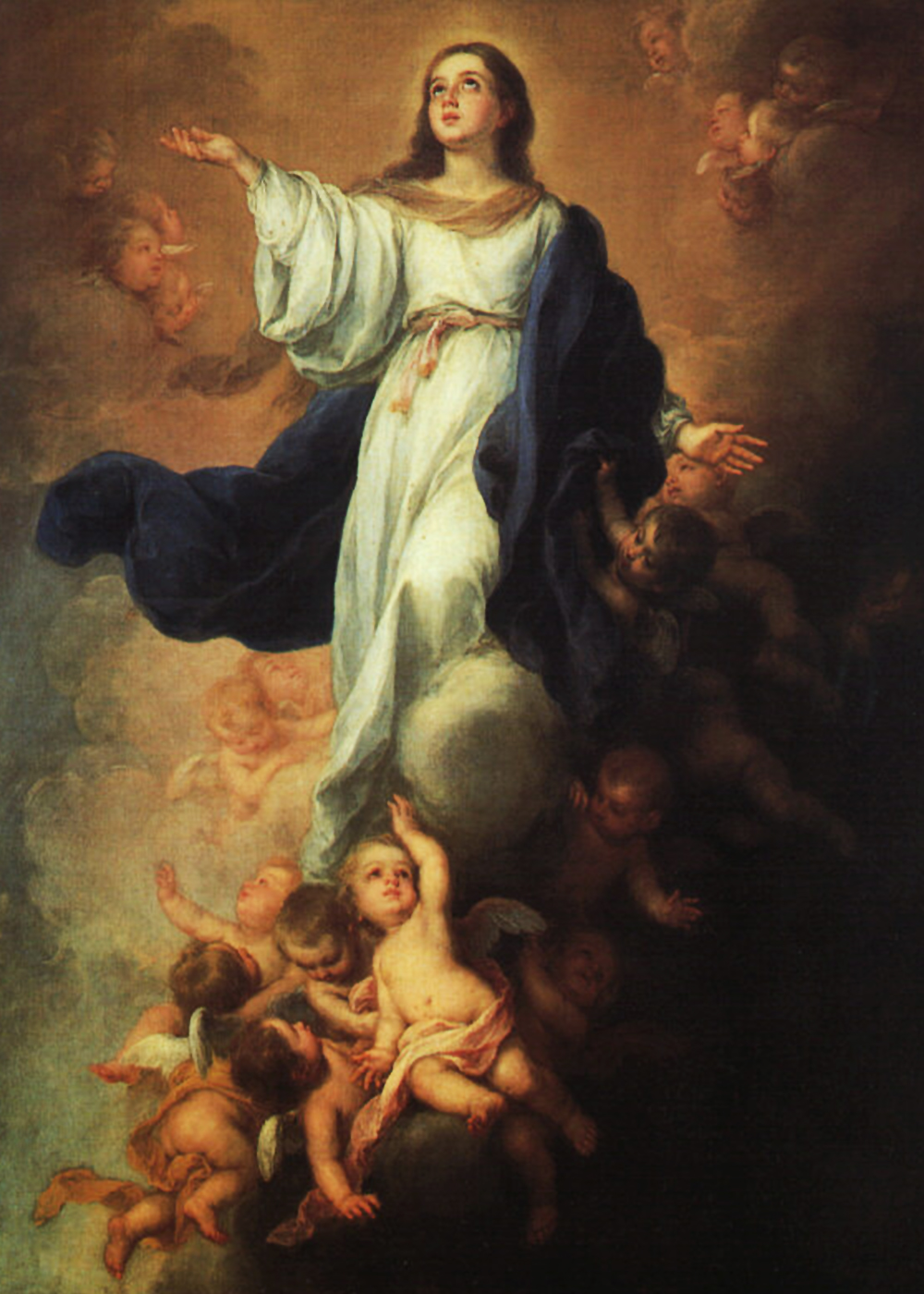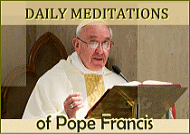Readings: Rv 11:19a; 12:1-6a, 10ab; Ps 45:10, 11, 12, 16; 1 Cor 15:20-27; Lk 1:39-56
Cardinal Newman, a Catholic convert had this to say about the Assumption of Mary: It was surely fitting, that she be taken up into heaven and not lie in the grave till Christ’s second coming, who had passed a life of sanctity and of miracle such as hers. Why should she share the curse of Adam, who had no share in his fall?
A couple of lovebirds dwelt in a huge golden cage and were treated royally by the king. Once the king forgot to close the cage and the female flew away. Fascinated by freedom, she returned to take her mate with her. But the male preferred captivity. “We live in a golden cage and the king provides everything,” he argued. “However,’ she explained, “Don’t you see that we’re born free, to fly unfettered?” The male disagreed: “Get away! let me enjoy royal peace!” Pained, she flew away alone towards freedom.
Mary, fully free, was taken up to heaven as the FIRST FRUIT of our human destiny. Mary’s Assumption reminds us that we are all heaven bound and it is precisely in doing God’s will that we attain full freedom. Like that foolish male lovebird let’s not be fettered by the enticements of false freedom, no matter how seemingly ‘royal’, but strive to make earth a true heaven for all its citizens.
Pope Pius XII defined the dogma of Mary’s bodily assumption in the Apostolic Constitution Munificentissimus Deus in November 1950: “Mary, the immaculate perpetually Virgin Mother of God, after the completion of her earthly life, was assumed body and soul to the glory of heaven.” The Pope purposely avoided entering into the question of whether Mary actually died or not. It was left an open question. The reason is because the Fathers of the Church have different opinions on this.
Since Mary was born without original sin, she has that gift of immortality. Some theologians say she did not die but only went to sleep before she was assumed body and soul to heaven. However, the most probable opinion was that she did die, since even her Son Jesus died and she wanted to be in union with her Son. But even if she died, her body was incorrupt and remained as fresh as if she was just sleeping. That is why the church dedicated to her in Ephesus where she was believed to have died is called the Church of Dormition. Dormition is synonymous to the word “sleep.”
Rev 11:19;12:1-6a, 10
On a symbolic level, the early Church identified itself with the heavenly Queen. It also identified the mother of Jesus as the heavenly Queen. After all, Mary was the first believer in the Good News. So, she was the first member of the Church. As the proto-member, she represents all who followed her, as disciples of her Son. If the Church saw itself in the cosmic struggle with the Evil One to make the Messiah present to the world, it could also see its first member in that role. It is no wonder that, by the time Constantine freed the Church from persecution, believers pictured Mary as the Queen of Revelation 12.
The picture of the cosmic struggle presents us with a challenge. Evil will try to prevent our efforts to show Christ to others, just as the author of Revelation painted. But this in not just a battle we fight alone. It is a universal battle. So, we need all the help we can muster. That is why the image of the Blessed Virgin Mary comforts us. She lived what we hope to live. She brought Christ into the world. With her prayers, we can do the same.
What is your devotion to Our Lady? How can such a devotion strengthen your Christian walk?
Second Reading: 1 Corinthians 15:20-27
What is our future? In his letter to the Corinthians, Paul defended the notion of the Resurrection and clearly laid out his vision for the future. Death represented the past. Resurrection represented the future. Notice the irony of the process. As Christ was raised from the dead, so shall his followers experience the same new life. With the resurrection comes the defeat of all cosmic powers that support death (“when HE can do away with all rule and authority and power”). The end times cumulate with the utter destruction of evil (“For, it is necessary for HIM to rule as KING until which (time) HE can place all enemies under HIS feet. “) and its result, death. Resurrection kills death itself!
Gospel: Lk: 1:39-56
Mary had reason for joy. Her status was not based upon local opinion, but upon her place in God’s plan. She was the first to accept the Good News at the Annunciation. Now she was an instrument of God’s will and power. For that reason, her reputation would spread from generation to generation. She would be the mother of the Savior. And, the Mother of God!
All generations would call her blessed. How do you honor the mother of Jesus in your life?
One woman blessed another. And the blessed reveled in that praise. But that blessing and praise was not only based in the joy of shared maternity. Both were based in the Spirit. For, as the Spirit worked through the women, it would work mighty deeds in their sons.
Reflect on the blessings in your life. Which ones come from family? Which ones come from the Spirit? Where do these blessings intersect? How are these blessings like those in the Gospels, especially those like Mary received?
The glorious Assumption of the Blessed Virgin Mary into heaven did not happen by her own power. She had no power of her own to undertake such a mysterious flight into heaven. It was purely the grace of God working in her. It is based upon this that we differentiate the Ascension of Jesus Christ into heaven (which was by his own divine power) and the Assumption of the Blessed Virgin Mary (which took place through the power of God).
There are no direct biblical references narrating the Assumption of the Blessed Virgin Mary into heaven, but there are strong biblical pointers as well as other events with inferential relationships.
• Isaiah 7:14. Here we are presented with the eternal Virginity of Mary. The word of God said that a Virgin shall conceive and bear a son. (Note well not a woman but a Virgin). A closer and more effective reflection shows us that after the birth of her child she remained a virgin. This also points to the fact that God aided the preservation of her virginity after having her child which actually happened through the power of the Holy Spirit. In effect she did not experience any form of physical mutilation on her body which is precious to God as the first tabernacle of our Lord Jesus Christ. Isaiah 60: 13 confirms that God will bless the place where His feet rest.
-
Luke 1:28. This is the only place in the entire bible that God spoke of someone as being full of grace or highly favoured. God had in the past extolled some men and women of virtue like David, Deborah, Gideon and others but none has been told that he or she was full of grace. Mary was also told that she was blessed among all women which is another significant value placed on her. It does really follow that one with such rare attribute deserves a special package before God.
-
Mystical experiences. This refers to a unique form of subjective religious experience which God allows some people to have. Outwardly this can be seen in some people experiencing one or two of those unique events in the Life of Jesus Christ. Examples are Stigmatism (bleeding at those spots Christ bled like Padre Pio), Bilocation (being at two places at same time like Alphonsus Ligouri and Anthony of Padua), Levitation (Being lifted up unaided by anything or person like Teresa of Avila), Glossolalia (Speaking in other tongues or languages like on the Pentecost day), Incorruption (body not decaying after death like Rita of Cascia and Bernadette Soubirous).Among these we relate Levitation and incorruption with Assumption as mystical experiences willed by God for our Blessed mother. Evidently this had happened with some people in the bible. In Genesis (5:24) we are told that Enoch suddenly was taken away. In 2 Kings (2:1-11), Elijah was taken up to heaven by a chariot of fire.
-
There is need for us to learn from Mary and honour her than getting ourselves busy with arguments about her life and suitability of her cooperation with God in the salvation of mankind. We learn from her:
-
HUMILITY: Let it be done to me according to your words.(Luke 1:38)
-
LIFE OF FAITH: She believed in the promise made to her by God.(Luke 1:45)
-
LIFE OF HOPE : She stood by the promise of God with ardent hope.(Luke1:55)
-
LOVE FOR GOD AND OTHERS: Her visit to Elizabeth and assistance at the wedding at Cana in Galilee. (Luke 1:39ff; John 2:3ff).
-
FEW WORDS BUT DEEP REFLECTION: She spoke only about four times in the bible. But she pondered all in her heart.(Luke 2:19).
As we celebrate the Solemnity of the Assumption, let us know also that our lives need to be assumed into holiness. We need to reflect in our lives what characterized the Mother of our Lord, and who is our own Mother also.
BE WITH US MARY ALONG THE WAY, GUIDE EVERY STEP WE TAKE, LEAD US TO JESUS YOUR LOVING SON NOW AND FOREVER.
Fr. Gaspar Fernandes, OFM Cap.


